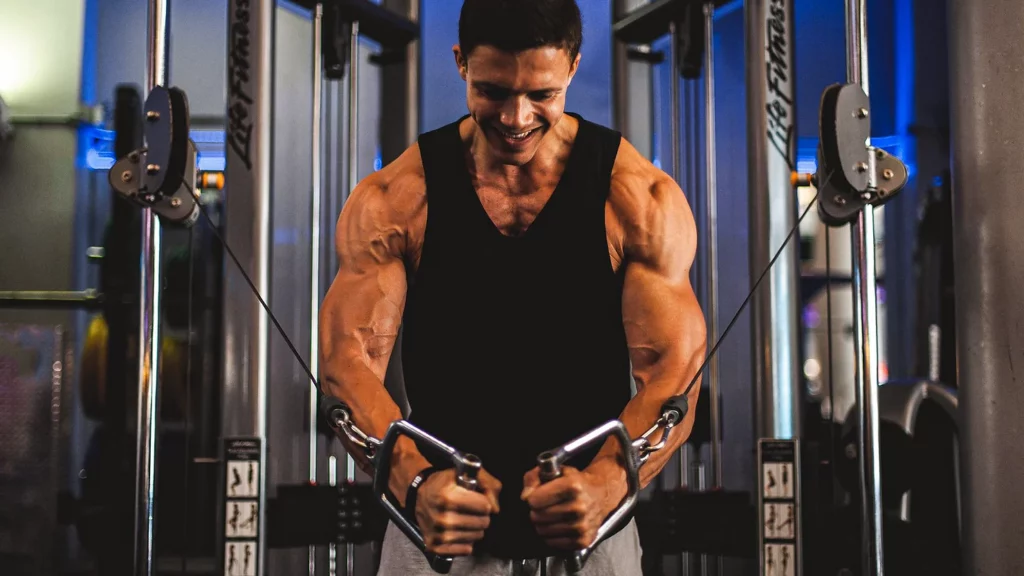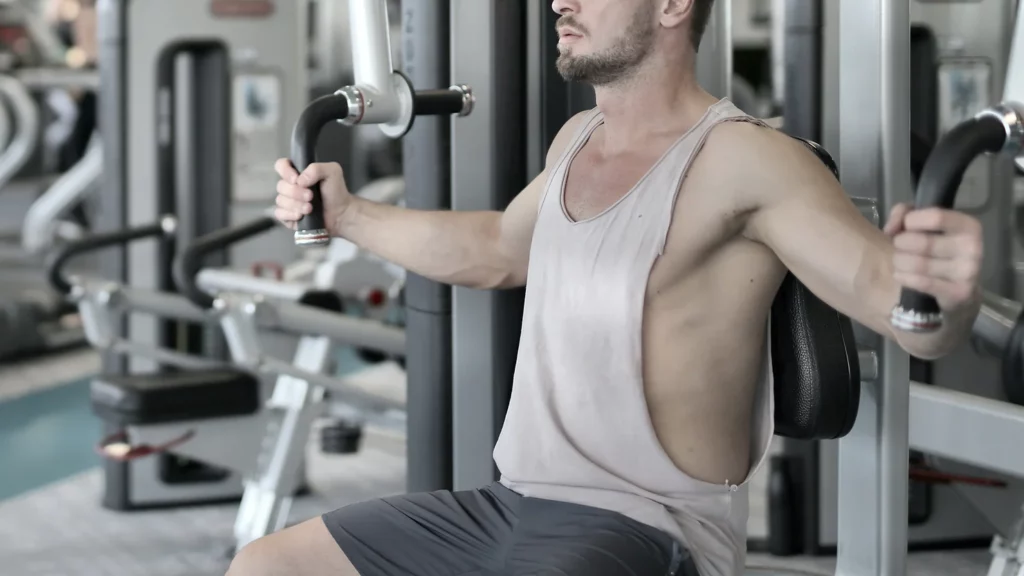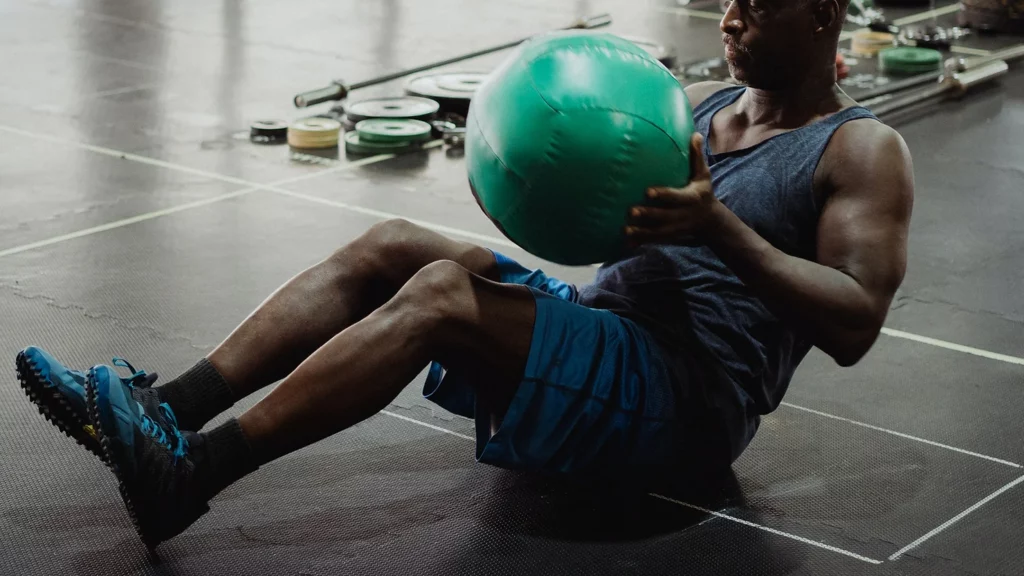What muscles does the cable fly work?
The cable fly primarily works the pectoralis major, which is the largest muscle in the chest. The pectoralis major is responsible for bringing the arms together in front of the chest. It also works the anterior deltoid, which is the front shoulder muscle. Secondary muscles worked include the pectoralis minor and the short head of the biceps. The cable fly is a great exercise for working the chest muscles and improving your performance.
The pectoralis major is a muscle in the chest that helps to bring the arms together in front of the chest. This motion is the main action in the cable fly exercise. It also works the anterior deltoid, which is the front shoulder muscle. The anterior deltoid plays a role in chest flys by helping to stabilize the weight and keeping the arms in the correct position. The pectoralis minor is a small muscle located under the pectoralis major. It helps to stabilize the shoulder joint and keeps the arm in its socket. The short head of the biceps is located on the front side of the upper arm. The biceps brachii is the muscle that flexes and extends the elbow joint. It helps to keep the weight stable when performing chest flies by assisting with arm stabilization.
Benefits of the Cable Fly
The cable fly exercise is a great way to build muscle in the chest, especially when paired with the barbell bench press, due to time under tension. Time under tension is the amount of time that a muscle is under stress during an exercise. The longer a muscle is under tension, the more it will grow. The cable fly exercise puts the chest muscles under a lot of tension due to the resistance provided by the cables. This makes it an effective exercise for building muscle.
The cable fly can be performed at various angles to target different muscles. For example, performing the exercise with your arms above your head will target the upper chest muscles more than the lower chest muscles. This is because the higher position of the arms puts more tension on the upper chest muscles. Alternatively, performing the exercise with your arms below your waist will target the lower chest muscles more than the upper chest muscles. This is because the lower position of the arms puts more tension on the lower chest muscles. This versatility makes the cable fly a great exercise for targeting the same muscle group in different ways.
The cable fly is also a great exercise for improving your performance. This is because the cable fly requires you to use stabilizer muscles, which are muscles that help to keep your body in balance. The stabilizer muscles are important for improving your performance because they help you maintain proper form and prevent injuries.
How to Perform the Cable Fly Exercise
The cable fly exercise is a great way to build muscle and improve your performance. In this section, we will discuss how to perform the cable fly exercise. We will also focus on the common mistakes people make when performing this exercise.
Setup
-
To set up for the cable fly exercise, you will need two cables and a weight stack. Attach the cables to the weight stack at the desired height. The higher the setting, the more difficult the exercise will be.
-
Next, adjust the length of the cable so that there is slack in the middle of the cable. This will allow you to bring your hands together in front of your chest without the cable becoming taut.
-
Lastly, attach the handles to the cables. Make sure that the handles are secure before starting the exercise.
Execution
-
To execute the cable fly exercise, start by standing in between the cables with your feet shoulder-width apart. Bend your knees slightly and lean forward at the hips so that your back is in a neutral position. This will be your starting position.
-
From here, press the handles together in front of your chest and squeeze your shoulder blades together. Hold this position for a moment before returning to the starting position.
-
Repeat for the desired number of repetitions.
Common Mistakes
One of the most common mistakes people make when performing the cable fly exercise is using too much weight. This can lead to poor form and increase your risk of injury. Make sure that you are using a weight that you can handle without compromising your form.
Another common mistake is not maintaining a neutral spine throughout the exercise. This can cause lower back pain and strain on the spine. Make sure to keep your back in a neutral position throughout the exercise. It is also necessary to keep the core engaged throughout the exercise. This will help to stabilize the spine and prevent injuries.
Furthermore, people don’t bend their elbows enough when performing the exercise. This can cause the weight to be unevenly distributed and put unnecessary strain on the shoulders. Make sure to keep your elbows slightly bent throughout the exercise.
Finally, some people swing their arms during the cable fly exercise. This can cause you to lose balance and increase your risk of injury. Make sure to keep your arms stationary throughout the exercise.
Variations of the Cable Fly
There are several variations of the cable fly exercise that you can perform.
Variation #1: Incline Cable Fly
The incline cable fly is an effective movement to work out the upper chest. The movement is similar to the traditional cable fly, but you will be performing the exercise on an incline bench.
Setup
-
Adjust the pulleys on the weight stack to the desired height. This will determine the level of difficulty of the exercise.
-
Next, adjust the length of the cables so that there is slack in the middle of the cable. This will allow you to bring your hands together in front of your chest without the cable becoming taut.
-
Attach the handles to the cables and set up a bench at a 45-degree angle in between the cable machine.
-
Lie on the bench with your back flat against the pad and your feet flat on the floor.
-
Position yourself so that the handles are at chest level. This will be your starting position.
Execution
-
Press the handles together in front of your chest and squeeze your shoulder blades together. Hold this position for a moment before returning to the starting position.
-
Repeat for the desired number of repetitions.
Variation #2: Decline Cable Fly
The decline cable fly is a powerful lower-chest workout. You’ll do the movement on a decline bench, similar to the traditional cable fly.
Setup
-
Adjust the pulleys on the weight stack to the desired height. This will determine the level of difficulty of the exercise.
-
Next, adjust the length of the cables so that there is slack in the middle of the cable. This will allow you to bring your hands together in front of your chest without the cable becoming taut.
-
Attach the handles to the cables and set up a bench at a decline angle in between the cable machine.
-
Lie on the bench with your back flat against the pad and your feet flat on the floor.
-
Position yourself so that the handles are at chest level. This will be your starting position.
Execution
-
Press the handles together in front of your chest and squeeze your shoulder blades together. Hold this position for a moment before returning to the starting position.
-
Repeat for the desired number of repetitions.
Variation #3: Seated Cable Fly
The seated cable fly is a great way to work out your chest muscles while sitting down. The movement is comparable to the regular cable fly but instead of standing, you will be sitting during the exercise.
Setup
-
Adjust the pulleys on the weight stack to the desired height. This will determine the level of difficulty of the exercise.
-
Next, adjust the length of the cables so that there is slack in the middle of the cable. This will allow you to bring your hands together in front of your chest without the cable becoming taut.
-
Attach the handles to the cables and sit down on a bench in between the cable machine the bench should be set somewhat upright.
-
Position yourself so that the handles are at chest level. This will be your starting position.
Execution
-
Press the handles together in front of your chest and squeeze your shoulder blades together. Hold this position for a moment before returning to the starting position.
-
Repeat for the desired number of repetitions.
Variation #4: Standing Cable Fly
The standing cable fly is an effective movement to target the chest while also working on core stability. The movement is very similar to the regular cable fly, but instead of sitting or lying down, you will be standing during the exercise.
Setup
-
Adjust the pulleys on the weight stack to the desired height. This will determine the level of difficulty of the exercise.
-
Next, adjust the length of the cables so that there is slack in the middle of the cable. This will allow you to bring your hands together in front of your chest without the cable becoming taut.
-
Attach the handles to the cables and stand in between the cable machine.
-
You can stagger your feet or have them shoulder-width apart, whichever is more comfortable for you.
-
Position yourself so that the handles are at chest level. This will be your starting position.
Execution
-
Press the handles together in front of your chest and squeeze your shoulder blades together. Hold this position for a moment before returning to the starting position.
-
Repeat for the desired number of repetitions.
Variation #5: High Cable Fly
The high cable fly is an excellent way to work the lower chest muscles. The movement is similar to the regular cable fly, but instead of having the cables at chest level, they will be set higher above your head.
Setup
-
Adjust the pulleys on the weight stack high above your head. This will target the lower chest more effectively.
-
Next, adjust the length of the cables so that there is slack in the middle of the cable. This will allow you to bring your hands together in front of your chest without the cable becoming taut.
-
Attach the handles to the cables and stand in between the cable machine.
-
You can stagger your feet or have them shoulder-width apart, whichever is more comfortable for you.
-
Position yourself so that the handles are above your head. This will be your starting position.
Execution
-
Press the handles together in front of your chest and squeeze your shoulder blades together. Hold this position for a moment before returning to the starting position.
-
Repeat for the desired number of repetitions.
Variation #6: Low Cable Fly
The low cable fly is a great way to target the upper chest muscles. The movement is similar to the regular cable fly, but instead of having the cables at chest level, they will be set lower below your waist.
Setup
-
Adjust the pulleys on the weight stack low below your waist. This will target the upper chest muscles.
-
Next, adjust the length of the cables so that there is slack in the middle of the cable. This will allow you to bring your hands together in front of your chest without the cable becoming taut.
-
Attach the handles to the cables and stand in between the cable machine.
-
You can stagger your feet or have them shoulder-width apart, whichever is more comfortable for you.
-
Position yourself so that the handles are below your waist. This will be your starting position.
Execution
-
Press the handles together in front of your chest and squeeze your shoulder blades together. Hold this position for a moment before returning to the starting position.
-
Repeat for the desired number of repetitions.
Cable Fly Alternatives
There are a few cable fly alternatives that you can do if you don’t have access to a cable machine.
Alternative #1: Dumbbell Fly
The dumbbell fly is a great alternative to the cable fly. The movement is very similar, but instead of using cables, you will be using dumbbells.
Setup
-
Grab a pair of dumbbells and lie down on a flat bench.
-
Hold the dumbbells above your chest with your palms facing each other. This will be your starting position.
Execution
-
Slowly lower the dumbbells out to your sides in a wide arc. Keep your palms facing each other throughout the entire movement.
-
When you feel a stretch in your chest, slowly reverse the motion and bring the dumbbells back to the starting position.
-
Repeat for the desired number of repetitions.
Alternative #2: Band Fly
The band fly is a great bodyweight alternative to the cable fly. The movement is very similar, but instead of using cables, you will be using a resistance band.
Setup
-
Anchor a resistance band to a sturdy object at chest level.
-
Grab the handles of the resistance band and stand in between the anchor point.
-
You can stagger your feet or have them shoulder-width apart, whichever is more comfortable for you.
-
Position yourself so that the handles are at chest level. This will be your starting position.
Execution
-
Press the handles together in front of your chest and squeeze your shoulder blades together. Hold this position for a moment before returning to the starting position.
-
Repeat for the desired number of repetitions.
Alternative #3: Machine Fly
The machine fly is an effective alternative if your gym has a pec deck machine. The movement is very similar, but instead of using cables, you will be using a weight stack.
Setup
-
Adjust the seat of the machine so that it is in line with your chest.
-
Grab the handles of the machine and sit down.
-
Position yourself so that the handles are at chest level. This will be your starting position.
Execution
-
Press the handles together in front of your chest and squeeze your shoulder blades together. Hold this position for a moment before returning to the starting position.
-
Repeat for the desired number of repetitions.
Alternative #4: Seated Chest Press
The seated chest press is a common machine found in most gyms. It is a great alternative to the cable fly if you are looking to build muscle.
Setup
-
Adjust the seat of the machine so that it is in line with your chest.
-
Grab the handles of the machine and sit down.
-
Position yourself so that the handles are at chest level. This will be your starting position.
Execution
-
Press the handles together in front of your chest and keep your shoulder blades squeezed together. Hold this position for a moment before returning to the starting position.
-
Repeat for the desired number of repetitions.
Summary
The cable fly is a great exercise for building muscle in your chest. The movement is simple, but it is important to focus on squeezing your shoulder blades together and keeping your palms facing each other throughout the entire movement. There are a few alternatives that you can do if you don’t have access to a cable machine, including the dumbbell fly, band fly, machine fly, and seated chest press. Whichever exercise you choose, make sure you focus on quality over quantity. Remember to breathe and keep your core engaged throughout the entire movement.
Are you looking to get fit? Look no further! Our fitness programs are designed to help you build a strong and aesthetic physique. We also provide easy-to-follow routines that will fit any schedule. With our fitness programs, you'll have the tools you need to build muscle and achieve your fitness goals. Click the link below to get started!



